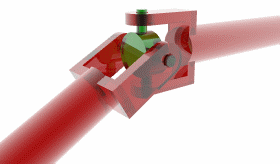Universal joint
Universal joint (also known as a U-joint, universal coupling, Cardan joint, or Hooke's joint) is a mechanical joint used to connect two non-parallel shafts at an angle, allowing them to rotate freely while transmitting torque. The basic design of a universal joint consists of a pair of hinges located close together, oriented at 90° to each other, connected by a cross shaft.
Design and Principle[edit | edit source]
The universal joint is considered a significant invention in the field of mechanics and engineering. Its design allows for the transmission of power between shafts that are not aligned on the same plane. The key components of a universal joint are the cross or spider, which has four legs, and two yokes, which are attached to the shafts. The cross sits inside the yokes, and the configuration allows the joint to move in any direction, accommodating angular misalignment of the shafts.
Applications[edit | edit source]
Universal joints are widely used in various applications where shaft alignment cannot be maintained or an angular misalignment is desirable. Common applications include:
- Automobiles: In the drivetrain and steering mechanisms to transmit power from the engine to the wheels.
- Aircraft: In the control mechanisms to transmit pilot inputs to the control surfaces.
- Industrial machinery: In conveyors, blowers, and other machinery requiring power transmission at varied angles.
- Driveshafts: As a critical component in the transmission of power in machinery and vehicles.
Advantages and Limitations[edit | edit source]
The primary advantage of a universal joint is its ability to transmit torque and rotational motion in applications where direct alignment is not possible. However, one of the limitations of a simple universal joint is its inability to maintain a constant velocity across the joint during rotation, which can lead to vibrations and wear over time. This issue is addressed in some applications by using a constant-velocity joint (CV joint).
Types of Universal Joints[edit | edit source]
Several types of universal joints exist, each designed for specific applications and requirements. These include:
- Single Universal Joint: The simplest form, used in applications where a single bend in the shaft alignment is required.
- Double Universal Joint: Consists of two universal joints combined, allowing for greater flexibility in angular misalignment.
- Constant Velocity Universal Joint: Designed to overcome the constant velocity issue, providing smoother power transmission.
Maintenance[edit | edit source]
Maintenance of universal joints involves regular lubrication to prevent wear and tear and checking for signs of wear or damage. In automotive applications, worn universal joints can lead to vibrations, noise, and eventual failure of the drivetrain components.
Conclusion[edit | edit source]
The universal joint is a critical component in the field of mechanical engineering, offering flexibility in the transmission of power between misaligned shafts. Its invention has enabled the development of complex mechanical systems in automotive, industrial, and aerospace applications.
Search WikiMD
Ad.Tired of being Overweight? Try W8MD's physician weight loss program.
Semaglutide (Ozempic / Wegovy and Tirzepatide (Mounjaro / Zepbound) available.
Advertise on WikiMD
|
WikiMD's Wellness Encyclopedia |
| Let Food Be Thy Medicine Medicine Thy Food - Hippocrates |
Translate this page: - East Asian
中文,
日本,
한국어,
South Asian
हिन्दी,
தமிழ்,
తెలుగు,
Urdu,
ಕನ್ನಡ,
Southeast Asian
Indonesian,
Vietnamese,
Thai,
မြန်မာဘာသာ,
বাংলা
European
español,
Deutsch,
français,
Greek,
português do Brasil,
polski,
română,
русский,
Nederlands,
norsk,
svenska,
suomi,
Italian
Middle Eastern & African
عربى,
Turkish,
Persian,
Hebrew,
Afrikaans,
isiZulu,
Kiswahili,
Other
Bulgarian,
Hungarian,
Czech,
Swedish,
മലയാളം,
मराठी,
ਪੰਜਾਬੀ,
ગુજરાતી,
Portuguese,
Ukrainian
Medical Disclaimer: WikiMD is not a substitute for professional medical advice. The information on WikiMD is provided as an information resource only, may be incorrect, outdated or misleading, and is not to be used or relied on for any diagnostic or treatment purposes. Please consult your health care provider before making any healthcare decisions or for guidance about a specific medical condition. WikiMD expressly disclaims responsibility, and shall have no liability, for any damages, loss, injury, or liability whatsoever suffered as a result of your reliance on the information contained in this site. By visiting this site you agree to the foregoing terms and conditions, which may from time to time be changed or supplemented by WikiMD. If you do not agree to the foregoing terms and conditions, you should not enter or use this site. See full disclaimer.
Credits:Most images are courtesy of Wikimedia commons, and templates, categories Wikipedia, licensed under CC BY SA or similar.
Contributors: Prab R. Tumpati, MD


